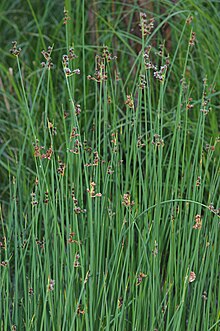| Schoenoplectus tabernaemontani | |
|---|---|

| |
| Scientific classification | |
| Kingdom: | Plantae |
| Clade: | Tracheophytes |
| Clade: | Angiosperms |
| Clade: | Monocots |
| Clade: | Commelinids |
| Order: | Poales |
| Family: | Cyperaceae |
| Genus: | Schoenoplectus |
| Species: | S. tabernaemontani
|
| Binomial name | |
| Schoenoplectus tabernaemontani | |
| Synonyms[1] | |
|
List
| |

Schoenoplectus tabernaemontani is a species of flowering plant in the sedge family known by the common names softstem bulrush,[2] grey club-rush,[3] and great bulrush. It can be found throughout much of the world; it has been reported from every state in the United States (including Hawaii), and from every province and territory in Canada except Nunavut. It grows in moist and wet habitat, and sometimes in shallow water.
Schoenoplectus tabernaemontani is quite variable in appearance, thus explaining the long list of synonyms that have been created over the years. It is a perennial herb producing dense stands of many narrow erect stems reaching 1–3 m (33–100 inches) in height. It grows from a long rhizome system. The leaves are mostly basal and have wide sheaths around the stems. The inflorescence is generally a panicle of spikelets on long, thin branches which spread, arch, or droop. The spikelets vary in color. There is usually a long, stiff bract alongside each spikelet or cluster of spikelets.
A cultivar of this species with bright horizontal white or yellowish stripes, S. tabernaemontani 'Zebrinus', is sold as an ornamental plant for water gardens and landscaping.[4][5] Solid white and yellow cultivars are also available.[6]
- ^ a b "Schoenoplectus tabernaemontani (C.C.Gmel.) Palla". Plants of the World Online. Royal Botanic Gardens, Kew. Retrieved 14 September 2024.
- ^ USDA, NRCS (n.d.). "Schoenoplectus tabernaemontani". The PLANTS Database (plants.usda.gov). Greensboro, North Carolina: National Plant Data Team. Retrieved 1 February 2016.
- ^ BSBI List 2007 (xls). Botanical Society of Britain and Ireland. Archived from the original (xls) on 2015-06-26. Retrieved 2014-10-17.
- ^ European Water Gardener
- ^ Australian Water Gardener
- ^ Darke, Rick. The Color Encyclopedia of Ornamental Grasses. Timber Press. 1999. pg 277.